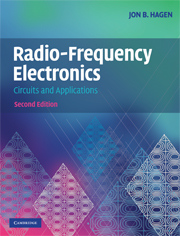Book contents
- Frontmatter
- Contents
- Preface
- 1 Introduction
- 2 Impedance matching
- 3 Linear power amplifiers
- 4 Basic filters
- 5 Frequency converters
- 6 Amplitude and frequency modulation
- 7 Radio receivers
- 8 Suppressed-carrier AM and quadrature AM (QAM)
- 9 Class-C, D, and E Power RF amplifiers
- 10 Transmission lines
- 11 Oscillators
- 12 Phase lock loops and synthesizers
- 13 Coupled-resonator bandpass filters
- 14 Transformers and baluns
- 15 Hybrid couplers
- 16 Waveguide circuits
- 17 Small-signal RF amplifiers
- 18 Demodulators and detectors
- 19 Television systems
- 20 Antennas and radio wave propagation
- 21 Radar
- 22 Digital modulation techniques
- 23 Modulation, noise, and information
- 24 Amplifier and oscillator noise analysis
- 25 The GPS Navigation system
- 26 Radio and radar astronomy
- 27 Radio spectrometry
- 28 S-parameter circuit analysis
- 29 Power supplies
- 30 RF test equipment
- Index
- References
27 - Radio spectrometry
Published online by Cambridge University Press: 05 June 2012
- Frontmatter
- Contents
- Preface
- 1 Introduction
- 2 Impedance matching
- 3 Linear power amplifiers
- 4 Basic filters
- 5 Frequency converters
- 6 Amplitude and frequency modulation
- 7 Radio receivers
- 8 Suppressed-carrier AM and quadrature AM (QAM)
- 9 Class-C, D, and E Power RF amplifiers
- 10 Transmission lines
- 11 Oscillators
- 12 Phase lock loops and synthesizers
- 13 Coupled-resonator bandpass filters
- 14 Transformers and baluns
- 15 Hybrid couplers
- 16 Waveguide circuits
- 17 Small-signal RF amplifiers
- 18 Demodulators and detectors
- 19 Television systems
- 20 Antennas and radio wave propagation
- 21 Radar
- 22 Digital modulation techniques
- 23 Modulation, noise, and information
- 24 Amplifier and oscillator noise analysis
- 25 The GPS Navigation system
- 26 Radio and radar astronomy
- 27 Radio spectrometry
- 28 S-parameter circuit analysis
- 29 Power supplies
- 30 RF test equipment
- Index
- References
Summary
Spectrometry or spectral analysis is the statistical characterization of random (stochastic) signals such as the IF voltage in a radio astronomy receiver, as described in Chapter 26. The spectrometers discussed in this chapter are all multiplex spectrometers, meaning that they measure N points on the spectrum simultaneously. This is to be distinguished from swept-frequency spectrum analyzers, which measure spectral points sequentially. Multiplex spectrometers are used when long integration times are needed to pull a signal out of the noise, as in radio astronomy. They are also used for low-frequency spectrum analysis, where narrow channel bandwidths require long measurement times to process a sufficient number of independent samples. Most often the signal is Gaussian; if a fine-grained histogram of samples of the signal's amplitude is scaled to make the area below the curve equal to unity, the average curve will be the Gaussian probability density function, f(V) = (2πσ2)−1/2 exp(−V2/2σ2). You can verify (Problem 27.1) that σ is the rms value of V, i.e., σ2 is the power, 〈V2〉. But total power does not completely characterize the signal. A complete description is contained in the power spectral density function, S(ω), the distribution of power vs. frequency. A set of bandpass filters and power meters, i.e., a set of radiometers, serves to measure points on the spectral density function (usually called the PSD or simply the power spectrum). However, the simplest mathematical definition of the power spectrum uses the signal's autocorrelation function, R(τ), a function of time delay.
- Type
- Chapter
- Information
- Radio-Frequency ElectronicsCircuits and Applications, pp. 375 - 389Publisher: Cambridge University PressPrint publication year: 2009



